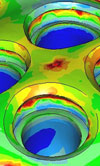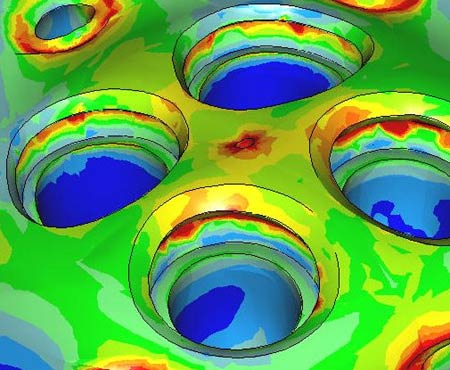Drilling could be cool
 In response to my earlier articles on cylinder head cooling, two comments were posted on the website by readers. Both are written more or less from the perspective of current cylinder head material and its limitations, providing enough food for thought on alternative concepts. The major driver is to achieve sufficient cooling for the several components in the cylinder head, preferably in combination with a simple and lightweight design.
In response to my earlier articles on cylinder head cooling, two comments were posted on the website by readers. Both are written more or less from the perspective of current cylinder head material and its limitations, providing enough food for thought on alternative concepts. The major driver is to achieve sufficient cooling for the several components in the cylinder head, preferably in combination with a simple and lightweight design.
Looking for alternatives, on the one hand possibilities for improving the existing material could be considered, such as shot-peening of critical areas like valve bridges. The goal is to put compression in the material, providing a higher load margin before critical tension occurs. As long as the temperature loading remains modest, this is a well known and popular technology.
At the other, more extreme end, a totally different cylinder head material could be thought of, combined with sophisticated machining capabilities in order to take away the overall traditional material limitations. One could think of fully or partly machined cooling jackets, and the requirement to gain machining access to the individual parts of the assembled cylinder head.
In between these conceptual ideas, there is a world of possibilities which, for many reasons, are not directly used on broader scale in current high-performance engines - reasons such as product cost, manufacturing lead times of components and the significant development time and cost required to bring a early concept to the required maturity level with which to go racing. That is why the concepts, which are not that far removed from common practice, are being developed for engine and component testing in order to be used in competition racing.
There are always two sides to looking at conceptual ideas. One should be able to think openly without being limited by manufacturability or whatever. Only this will lead to thinking 'outside the box', often generating further ideas. On the other hand, there is always the need to 'come back to earth', in order to get the real component on the test bench.
Would there be a concept for cylinder head cooling that outperforms current known water jacket designs? Let's take a look.

Although in the comment placed on the website by a reader named Terry, the idea was expressed to get rid of the coolant by a different material choice, I have taken a somewhat less extreme approach in this case, recognising the absolute must for a liquid-cooled engine.
When considering cooling of the cylinder head, the main area of interest is the valve bridge area, more specifically the exhaust valve bridges. The second area of interest is the exhaust port area, although design-wise the port length in the cylinder head could be shortened significantly, reducing thermal loading and therefore reducing the need for cooling this area. A neat example of a minimalistic design of cylinder head port lengths is the Cosworth CA cylinder head.
Focusing on the exhaust valve bridge area, conceptually the distance between coolant and flame deck is of critical importance. To achieve the shortest distance from coolant to valve bridge, and maintain sufficient wall thickness and strength, a possible solution would be to include drillings through (and parallel to) the flame deck exactly between the valve seats. This design is used in very large engines, where obviously there is more room for drillings.
In order to investigate the potential on cooling, concept CAE simulations have been carried out on a very simplified cylinder head model - just a square box, including four valves and ports. These simulations have shown the potential of this concept on cooling, with increased structural behaviour, due to the fact that the flame plate thickness can be increased as it no longer needs to be as thin as possible for cooling purposes. The temperature of the exhaust valve bridge could be significantly reduced, and the temperature on the flame deck could be kept far more homogeneous, resulting in less distortion and stress.
Analysing the possibilities of drilling these kind of coolant channels into the flame deck of the cylinder head led to a couple of 'challenges'. One major issue is the available wall thickness and clearance between the valve seats to drill through. Nowadays the seats are located so near to each other (maximum valve size:bore ratio) that hardly any material is left to drill through. To overcome this, one could think of getting rid of valve seats as separate inserts, and creating a wear-resistant seat in the cylinder head parent material.
A second area of attention is the spark plug dome. A specific detailed design would be required not to have the spark plug in direct contact with coolant, leading to possible leakage paths. Both these challenges, however, look as they could be overcome by smart engineering.
I have described a possible conceptual approach here that could lead to a simpler, more efficient cylinder head design, again from a cooling perspective. Would the conceptual advantage be of sufficient magnitude in order to replace current thinking? I would be interested in your ideas.
Fig. 1 - Conceptual cylinder head design: deformation
Written by Dieter van der Put